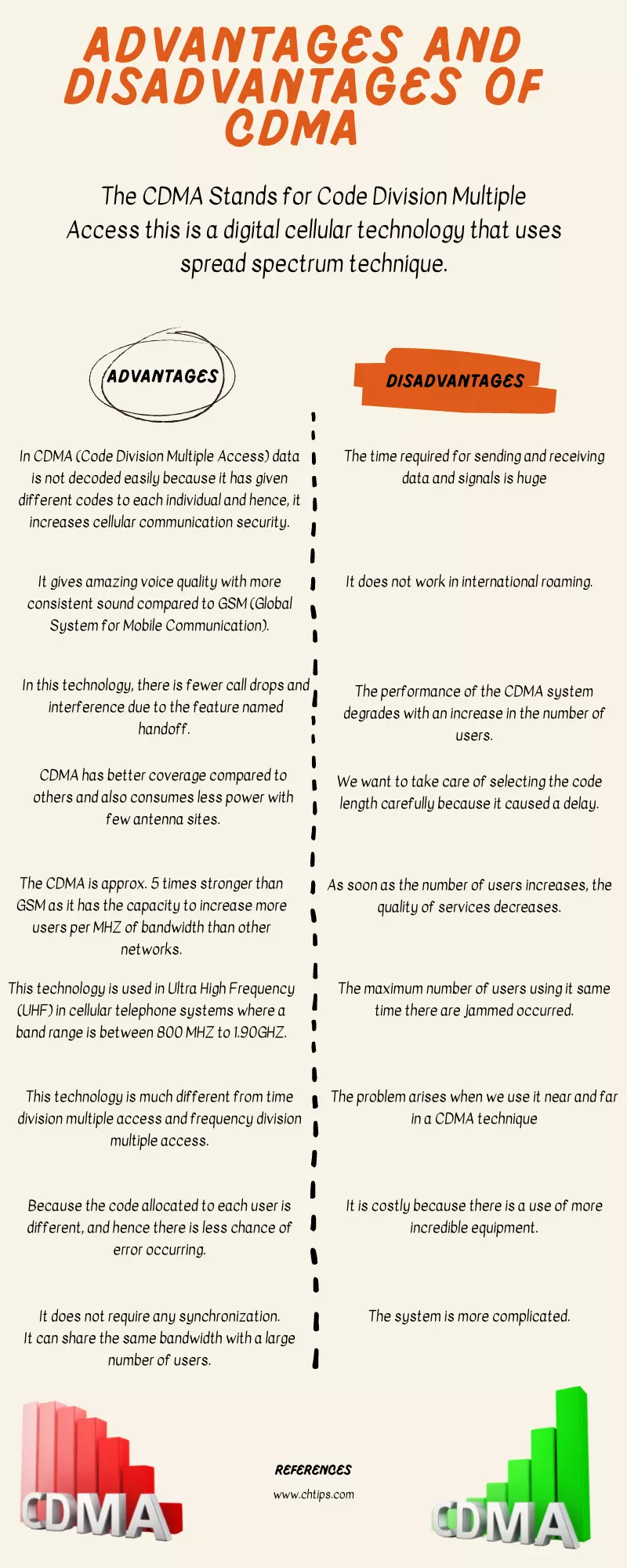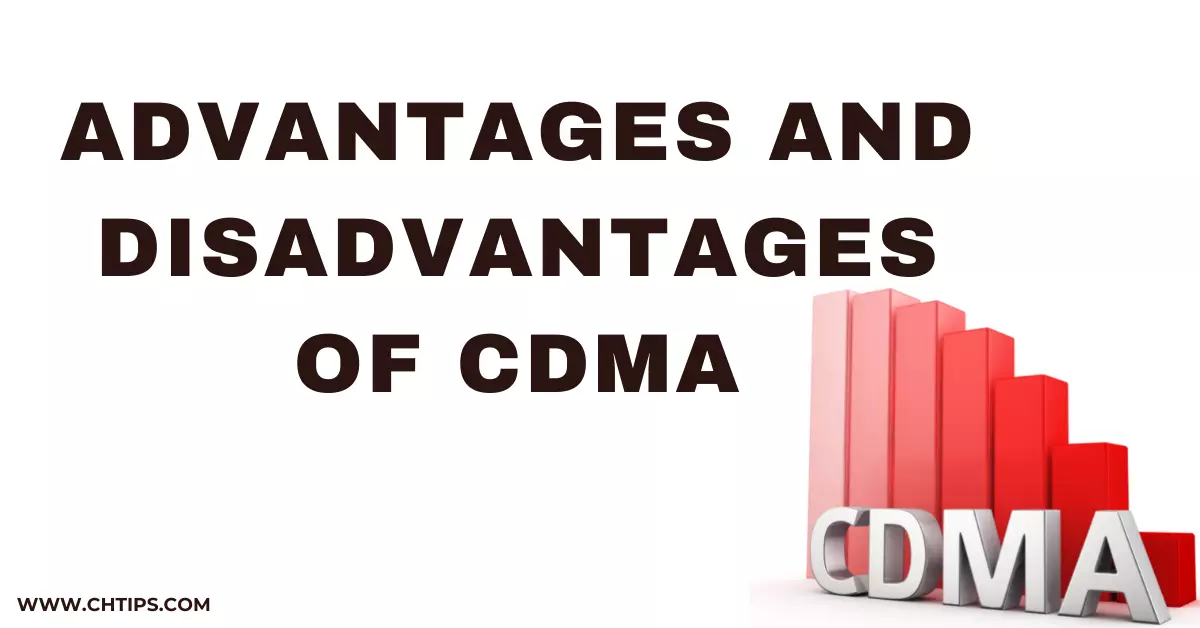In today’s article, we will discuss and learn 10 advantages and disadvantages of CDMA | drawbacks and benefits of CDMA technology with definition, features, applications, and uses with images & examples.
The CDMA Stands for Code Division Multiple Access this is a digital cellular technology that uses the spread spectrum technique.
CDMA does not use a specific frequency that is not assigned to the user instead they use the available spectrum.
In CDMA security is the main concern area where the individual conversation is encoded. This technology possesses good data and voice communication compared to others.
What is CDMA in Wireless Communications?
CDMA (Code Division Multiple Access) is a kind of multiplexing that facilitates various signals to occupy a signal transmission channel.
It uses the bandwidth in the best possible manner for better performance and usability.
This technology is widely found in ultra-high-frequency (UVF) cellular technology systems, with bands ranging between 800 megahertz (MHz) and 1.9 gigahertz (GHz).
It is a type of cellular technology with two main systems: a base system while the other is mobile subscribers for the user.
Some protocols are used in second-generation (2G), and third-generation (3G) in wireless communications.
It forms multiplexing, which allows multiple signals to settle in a single transmission channel, and it optimizes the use of available bandwidth.
In CDMA, It communicates with various codes it sends data to every station simultaneously.
Advantages and Disadvantages of CDMA

Advantages of CDMA in Wireless Communication
- In CDMA (Code Division Multiple Access) data is not decoded easily because it has given different codes to each individual and hence, it increases cellular communication security.
- It gives amazing voice quality with more consistent sound compared to GSM (Global System for Mobile Communication).
- In this technology, there are fewer call drops and interference due to the feature named handoff. (Handoff can be explained as transferring an ongoing call or data session from one channel connected to the core network to another channel).
- CDMA has better coverage compared to others and also consumes less power with few antenna sites.
- The CDMA is approx. 5 times stronger than GSM as it has the capacity to increase more users per MHZ of bandwidth than other networks,
- It gives a better multipath performance.
- It is highly secured from hackers.
- The individual conversation is encoded with the help of a pseudo-random digital sequence.
- This technology is used in Ultra High Frequency (UHF) in cellular telephone systems where a band range is between 800 MHZ to 1.90GHZ.
- This technology is much different from time division multiple access and frequency division multiple access.
- With this technology, users can access total bandwidth.
- The different color codes are used by other users.
- It does not require any synchronization.
- It can share the same bandwidth with a large number of users.
- It matches well with the other cellular technologies.
- Because the code allocated to each user is different, and hence there is less chance of an error occurring.
Disadvantages of CDMA
- The time required for sending and receiving signals or data is at once.
- It does not work in international roaming.
- The performance of the CDMA system degrades with an increase in the number of users.
- We want to take care of selecting the code length carefully because it caused a delay.
- As soon as the number of users increases, the quality of services decreases.
- The maximum number of users using it same time there are jammed occurred.
- The problem arises when we use it near and far in a CDMA technique.
- It is costly because there is a use of more incredible equipment.
- The system is more complicated.
How CDMA Works
In Code Division Multiple Accesses, every mobile station is allocated a different access code. This code differentiates the mobile user.
Every user on the network who is connected to a particular station will be separated by a unique code; a special code separates known as code division multiple access.
Let us consider that on the transmitter side, there are two users: A and B.
The narrowband signal has a unique code allocated to it; before transmission, all the signs will be multiplied with a unique code called the PN sequence code.
These narrowband signals are converted to a wideband signal, and similarly, the same process will be applied to other numbers of the system.
As we notice, code A is different from code B, so each user gets other codes, the basic principle behind CDMA.
So when the code is multiplied with the narrowband signal generated by the user, narrowband signals are converted into wideband signals.
All the wideband signals will be transferred over the radio spectrum that is our channel.
Each user sends a signal over a channel, which can be replicated over there; all users use a white band signal.
And on the receiver side, if I want to decrypt the only signal of user A, then we use that code used on the transmitter side the receiver side uses the same code.
So it again covers the wideband signal to the narrowband signal, and all the remaining white band signal remains assets, so the frequency we want to decrypt the signal will be processed further for the data replication processes.
This is defined as the working style of Code Division Multiple Access (CDMA).
Related Articles
- 20 Advantages and Disadvantages of Mobile Phones
- Characteristics of Fourth Generations of Computer
- Functions of Primary Memory in a Computer
- Different Types of Plotters
- Advantages and Disadvantages of Microcontroller
- Advantages and Disadvantages of Magnetic Disk
- Advantages and Disadvantages of Optical Disk
- Advantages and Disadvantages of Microprocessor
- 20 Advantages and Disadvantages of Mobile Phones
- Advantages and Disadvantages of CRT Monitors
- Advantages and Disadvantages of CCTV Cameras
- Advantages and Disadvantages of Blu-Ray Disk
- Advantages and Disadvantages of Fifth Generations of Computer System
- Advantages and Disadvantages of Bluetooth
- Advantages and Disadvantages of Grid Computing
- Advantages and Disadvantages of SATA
- Advantages and Disadvantages of Speakers
- Advantages and Disadvantages of IGBT
- Advantages and Disadvantages of ATM
- Learn Computer Fundamentals
- Computer Basic Tutorials
What is the Difference Between CDMA and GSM?
| GSM | CDMA |
| GSM stands for Global System for Mobile Communication. It is a digital mobile communication network used to give or receive data and voice signals over a network. | CDMA stands for Code Division Multiple Access; it is a radio communication signal similar to GSM. |
| GSM is called the second-generation standard for mobile networks and telecommunication. | CDMA was used in wireless communication on second generation (2G), and third-generation (3G) existed. |
| GSM uses the TDMA (Time Division Multiple Access) and FDMA (Frequency Division Multiple Access) to separate the users and cells and transmit the signals. | CDMA is based on a spread spectrum technology and makes optimal use of available bandwidth. It allows each user to transmit data over the entire spectrum at any time. |
| GSM operates on three different frequencies, which are 900 MHz, 1800 MHz, and 1900 MHz. | CDMA use (UHF) ultra-high frequency cellular system with frequency bands ranging between 800MHz to 900GHz. |
| With GSM technology, we have low-cost mobile set base stations. | CDMA technology has high-cost technology. |
| In GSM, the transmission rate is slow compared to CDMA. | In CDMA, the transmission rate is fast as compared to GSM. |
| GSM is SIM-specific; hence it requires a SIM card for communication. | CDMA does not need any SIM for communication purposes. |
| GSM gives less secure communication compared to CDMA. | CDMA required good secure communication purposes. |
| In GSM, signal detection is easy. | The detection of the signal is problematic in CDMA. |
Features of CDMA
Frequency usage: All the user information are transmitted in the same frequency slot even then information is not mixed up because every PN sequence is a unique sequence, EDD and FDD is a duplex method in which the information has been transmitted.
Soft capacity limit: In these systems, we have a weak capacity, i.e. we can increase as many users as possible, but the only requirement is to have that many different codes.
Soft handoff: Frequency remains the same, but only the channel has been transferred to the new base station for communication.
Near-far effect: The user who is far from the base station is transmitting with a low power level, and who is near the base station is sharing with a high power level.
Applications of CDMA
- It is used in military and commercial applications.
- It is used in mobile communications.
- It is used in radar and navigation systems.
Get In Touch
I have also written and compiled some articles on computers and telecommunications, and please go through them.
I hope you will like reading it.
I hope that all the questions and queries related to the Advantages and Disadvantages of CDMA Technology | Benefits and Drawbacks of CDMA have been answered here.
If you have any questions related to the Pros and Cons of Using CDMA.
Don’t hesitate to get in touch with me, and if you need to add, remove or update anything from the article, please let me know in the comment section or via email.
I will be more than happy to update the article. I am always ready to correct myself.
Please share this article with your friends and colleagues; this motivates me to write more related topics.
!!! Thank You !!!

Comments are closed.